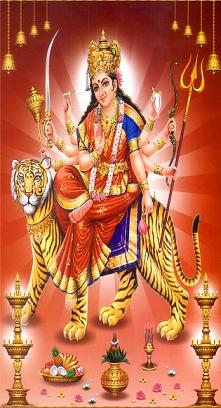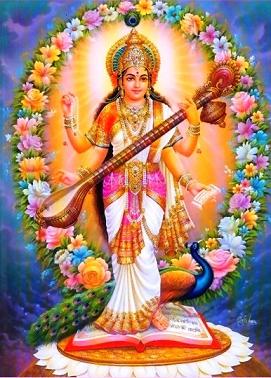|
The worship of the
female goddess developed into the widely practised form of
devotional worship known as Tantrism. The goddess such as the
Kali became the focus of worship which often involved animal and
human sacrifices and ritual practices that flew in the face of
wider Hindu moral and legal codes. The evidence of these
practices can be still seen in the art and sculpture of some
major temples. Devi, or Mahadevi is the most complex and the
most powerful of the goddesses. She owes various characteristics
with the combination of her descent traced back to the great
Mother Goddess of the ancient times and to Shakti, the active
dimension of the godhead, the divine power that underlies the
godhead’s ability to create the world and to display itself.
Shakti is a female divinity who is often worshipped in the form
of Durga. Devi or shakti assumes gentle and terrible forms. In
the gentle form she displays positive roles like fertility,
protection, establishment of religious order, cultural
creativity, duty and material abundance. Some important examples
of these forms are Lakshmi, Saraswati, Sati, Parvati and Prithvi.
In the terrible form, she plays her most fundamental protective
role, guardian of the cosmos in the form of a formidable
warrior. Besides supplicating the goddess for the bestowal of
favor, her worshippers also invoke her for active and sometimes
violent assistance against demons, terrors and disasters. This
contributed to the development of a group of fierce-looking
female deities. Once female deities became fully independent
they responded to the usual forces in Indian religion to take on
different forms. They make the vehicle as simulation of
non-Hindu mythology
and practice in the same way as their male counterparts. While,
some goddesses have strong maternal natures, some are domestic
and closely identified with male deities, some are embodiment of
art and culture and associated with the wild untamed fringes of
civilization and have strong independent natures and are great
warriors. There are large number of goddesses in Hinduism. Apart
from the innumerable village goddesses there are also the
geographical goddesses associated with specific regions. Some of
the important groups of goddesses are the Nava-Durgas, the Sapta
Matrikas and 10 Mahavidyas.
|
|
|
|
|
Durga |
|
The
goddess Durga is also the consort of Shiva after
Parvati. She is one of the most important female
deities of the Hindus. She normally has eight arms and
may hold a trident, sword, snake, bell, drum, shield,
cup, bow, wheel, conch-shell, mace, arrow or water pot
in her hands. She is shown seated in ‘sukhasana’
posture on a double lotus throne or on a lion. She may
wear a garland of skulls. Durga’s relations with Shiva
are sufficiently remote. She is referred as the
‘shakti’ of the impersonal absolute and as being
worthy of worship for material gains in this world and
spiritual advancement. Durga has nine popular forms
called Nava Durgas which are worshipped during the
Navratra festival. They are Shailaputri, Brahmacharini,
Chandraghanta, Kushmanda, Skandamata, Katyayani,
Kalaratri, Mahagauri and Siddhidhatri. Durga Puja is
one of the chief festivals of India celebrated in
September and October. It is celebrated in various
parts of
India in different styles but the basic aim of this
celebration is to propitiate shakti, the Goddess in
her aspect as Power. In this festival, the motherhood
of God is emphasized. It is a ten-day festival, where
each of the nine nights are dedicated to different
aspects of goddess Durga. This festival is celebrated
as the victory of the goddess Durga over Mahahasura,
the demon in the form of a buffalo. In many parts of
India a buffalo is sacrificed to commemorate this
event. |
 |
|
|
|
|
|
Lakshmi |
 |
The
goddess Lakshmi is the consort of Lord Vishnu and the
goddess of wealth and good fortune. She has four arms
when worshipped on her own, but has two when shown
with Vishnu. She holds a lotus in each of her upper
hands. Gold coins can be seen dropping down from the
palms of her lower two hands or one of them may be in
a boon-giving posture. She is normally painted in a
bright golden colour and is shown seated or standing
on a lotus. In paintings she is sometimes shown with
two elephants, half submerged in water, one on each
side. Lakshmi was born from the churning of the oceans
by the gods for amrita. Lakshmi is also associated
with beauty and is one of the most popular Hindu
female deities. It is due to the underlying human
desire for wealth, she absorbed a large number of folk
elements during her evolution into a widely accepted
members of the pantheon. Some of these may be
discerned in the qualities attributed to her as
Vishnu’s wife in several of his incarnations. As Sita,
she was said to have been born from a
furrow, showing her link with
agriculture. |
|
This symbol is again
emphasized when she is called as the Earth (Dharani).
Diwali, the festival of lamps is associated with
Lakshmi and is celebrated all over India. During the
festival, little lamps are lit all over the house in
the belief that Lakshmi will not enter a house if it
is dark. Every city, town and village is turned into a
fairyland with thousand of flickering oil lamps and
electric lights illuminating the homes. This is also
the time when all the houses are thoroughly cleaned
and freshly painted, rice-flour designs are made on
the doorsteps and crackers are burst by children. The
new commercial year for Hindu businessmen also begins
with Diwali. |
|
|
|
|
|
Parvati |
|
The
goddess Parvati, the consort of Lord Shiva, is
represented as a fair and beautiful woman. Few
miraculous deeds are claimed for her. It is only when
she appears as Durga, Kali, etc., that she manifests
divine powers and exhibits a very different spirit.
When Parvati is shown alone, she may hold a javelin
and a mirror in her two hands. If she is four handed,
two of her hands exhibit the protection and
boon-giving position and two carries a javelin and a
chisel. As Kali she became an ascetic whose severe
penances were intended to attract the attention of
Shiva. When Shiva teased her about her black skin,
through penances she changed her color to gold and was
then called Gauri. Parvati is worshipped as a minor
deity in a Shiva temple. Between the 5th and the 13th
centuries, from being merely the consorts of the male
deities, and their active partners, female deities
became independent and objects of worship in their own
right in which they have a temple and were the main
icons in that temple. It was around this time that
Parvati became a major deity as Durga and Kali. |
|
|
|
|
|
Saraswati |
|
Saraswati,
the goddess of learning and knowledge, is represented as an
extremely beautiful woman with a milk white complexion. She
normally wears white clothes, sits or stands on a water lily
and has four arms. With one of her hands she presents a lotus
to her husband, by whose side she constantly stands, and in
the other hand she holds a book of palm leaves indicating
learning. In one of her left hands she has a string of pearls
and in the other she may hold a small vase or the hand may be
in a boon giving pose. She is also represented with two arms,
playing a stringed musical instrument called the Veena. She
may also hold a conch, wheel, noose, skull cap, cup of
ambrosia, goad and mace. She presides over and protects the
arts and is credited with the invention of writing. She is
also the goddess of speech, the power through which knowledge
expresses itself. In the Vedas, Saraswati is described mainly
as a river but in the hymns she is described as a river and
deity. Her origins are obscure but it is possible that she
once had something to do with the river Saraswati in Rajasthan
or with water in some other way. |
 |
|
At all
events, it seems to have been associated with
the creative properties that water has for
seeds and vegetation. Being the goddess of
learning, she is worshipped when a child is
given instructions for the first time in
reading a writing. Many schools in India start
classes with a mass prayer to the goddess. In
the Saraswati Puja or the Vasant
Panchami, the goddess Saraswati is worshipped. In this
festival, the musical instruments, pens, paint brushes
and books are cleaned and placed on an altar. These
are worshipped as being the abode of the goddess. In
the absence of an image, sometimes an ink pot or
flowers are placed on a book and prayers from the
scriptures are chanted. |
|
|
|
|
|
Ganga |
|
The river
Ganga is the most sacred river in India. Most of the
holy cities of India like Rishikesh, Haridwar,
Varanasi, Allahabad are located on the banks of the
Ganga. Those who die within the specified limits of
Ganga go to the heavenly world. If after cremation the
ashes are thrown into the Ganga, then also the same
purpose is served. No Hindu can speak a falsehood with
the Ganga water (Gangajal) in his hand. The goddess
Ganga is represented as a fair-complexion woman,
wearing a white crown and sitting on a crocodile. She
holds a water lily in her right hand and flute in her
left hand. When shown with four hands she carries a
water-pot, lily, rosary and has one hand in a
protective mode. The story of Ganga’s origin is very
interesting. Sagar, a king of Ayodhya, had no
children. After doing a long penance, he got sixty
thousand sons. He then decided to perform a horse
sacrifice. Indra, the lord of the heavens, when heard
of this, got scared and stole the horse and took it to
the nether region. The sixty thousand sons reached the
nether region after searching him on earth and
manhandled a sage by mistake, thinking he had stolen
the horse. The sage got angry and cursed them and
turned them to ashes. Sagar on hearing this prayed to
Goddess Ganga to come down to earth with her water to
bring salvation to his sons. His son and grandson also
carried out the penance and it was only Bhagirath, the
great grandson, who managed to propitiate Ganga. The
Goddess Ganga came down on earth in a rush, but her
impact was reduced after her water was carried by the
Shiva’s mated hair. She was led to the nether regions
by Bhagirath. Hence the Ganga is divided into three
parts which are Mandakini, Ganga and Bhagirathi. The
Mandakini remained in the heavens, whereas the Ganga
came down to earth, and the Bhagirathi flow in the
nether region, and is named after the king Bhagirath.
|
|
|
|
|

